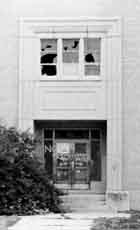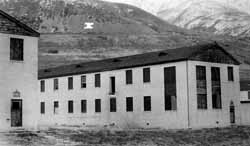What is that ‘I’?
Many people have driven through Brigham City and noticed the large “I” adorning the southeast side of the canyon.
What most people don’t know is that it stands for the Intermountain Indian School, a boarding school for Navajo children.
The school, which is in Brigham City, was originally the Bushnell Army Hospital, which was open from 1942 to 1947 serving wounded soldiers of World War II.
The land was donated by the city to the federal government so Brigham could get the hospital, said Sharon Brailsford, the mayor’s executive assistant. Doctors, nurses, military personnel, wounded patients and their families arrived in Brigham City to work at Bushnell.
After the hospital’s closure, the buildings sat empty for a short period while the city decided what should be done with the land.
“There were several proposals that came in,” said Larry Douglass, the Brigham City Museum and Art Gallery director. “One was for a boy’s academy. But in 1948, they got the proposal for an Indian school.”
The estimate for remodeling, new construction and equipment was $3.75 million. President Harry Trueman signed the bill allocating the money in May 1949, according to information provided by the museum.
The superintendent and a few assistants began working On June 4, 1948, and by January of 1950, 542 students were accepted at the federally run Intermountain Indian School. Since that time, the school was authorized to enroll 2,150 students, according to information from the museum.
It was for Navajo children who were bused from Arizona and were taught from elementary to high school, and it had its own medical facility and printing press, Douglass said.
The school was for Navajo because that tribe had the most school-aged children. The reservation didn’t have enough water or resources to provide for more than a fraction of the Navajo population, so the students were sent to boarding schools, according to information from the museum.
“The thought was that this boarding school could provide a better education for these children. It could give them an opportunity to manage a successful life off of the reservation,” said Shirley Hardman, a Cache Valley resident for more than 50 years. “Some people thought that there were alcohol problems on the reservation and that without a school, it would create a cycle of non-productivity and alcoholism.”
Bruce Perry, the executive director of the Northwestern Band of Shoshone in Brigham City, said there weren’t enough schools on the Navajo reservation.
“There was a time when there was a lack of schools on the reservations, and the federal government stepped in to see that the Navajo children were receiving the education they needed,” he said.
In 1954, 24 students graduated. In 1955, that number jumped to 188. By 1981, 5,319 students had graduated from the school, according to information provided by the museum.
It was successful as a Navajo boarding school. But enrollment was down in the late 70s, so the school was changed to the Intermountain Inter-Tribal School. It grew to having students from nearly 100 tribes. The school brought American Indians from all over the nation, Douglass said.
“We had kids from big cities in the Midwest and kids straight from the reservation that didn’t speak English,” said Douglass, who taught at the school for six months. “It was kind of a weird mix of city kids and rural, isolated kids.”
The school had problems with fighting between the tribes after class, although the students were well-behaved and respectful during lessons, Douglass said.
Douglass said he liked teaching art at the school because the visual arts are a part of the America Indian culture, and they had a natural understanding of the topic.
However, not everyone agreed that placing American Indian children into white-run boarding schools was a good thing because it caused them to change their culture.
In 1918, schools like the Carlisle Indian School in Carlisle, Pa. said their mission was to shape identity.
“Their purpose was to transform American Indian children into resembling their so-called civilized American brothers and sisters,” stated the Carlisle Indian School Web site.
But Sitting Bull of the Teton Sioux tribe said, “If the Great Spirit had desired me to be a white man, he would have made me so in the first place. He put in your heart certain wishes and plans; in my heart he put other and different desires. Each man is good in the sight of the Great Spirit. It is not necessary that eagles should be crows.”
The Carlisle Indian School gradually changed its purpose to influence rather than transform.
It was 40 years after the Carlisle school experiment of integrating American Indians into mainstream culture that the Intermountain Indian School in Brigham City opened its doors.
“The Intermountain Indian School for Navajo students was started in a more enlightened period,” Perry said. “We were no longer trying to force our culture on the Native Americans. The School was simply giving them an option through the federal government to gain a decent education.”
Douglass said the philosophy is looked down upon now, but it was accepted at the time of the school.
“It’s criticized now because our philosophy of dealing with Native Americans has drastically changed,” he said. “But at the time, it was ‘let’s educate and integrate them to become white men like us.’
“But I think the training was invaluable. The kids learned English, and some of them really enjoyed their stay there and have fond memories of being there.”
The Intermountain Indian Schools was one of the last Indian school to remain open. It closed in 1984 because the Bureau of Indian Affairs was trying to close most of its Indian schools, Douglass said.
“They wanted the schools to be near home. Instead of shipping the kids away from their families, they wanted to build reservation schools for the kids,” he said.
Following the school’s closure, city officials submitted a master plan in Washington, D.C. to get the 17 acres along U.S. Highway 91 back from the federal government. The agreement reached was that the land would remain open space and not be used for anything other than recreation, and it was deeded back to the city, Brailsford said.
Brigham City turned the open land into a golf course and sold the rest to fund the golf course. Objects from the buildings sold for $100,000, and property was sold for $2.5 million, Brailsford said.
Currently, some of the buildings remain vacant and some have been torn down, but the dormitories have been turned into townhouses called Eagle Village. A furniture store, a consulting firm, a martial arts company and various churches all house their businesses on the former home of the Intermountain Indian School, said Monica Holdaway, the executive assistant at the Brigham City Chamber of Commerce.
–karalcam@cc.usu.edu–kcartwright@cc.usu.edu

The doors to the building that once housed the language arts, library media center and listening center are boarded over and spray-painted with “No Trespassing.”

Painted on the mountain is an “I” that stands for Intermountain Indian School. It looks down over what remains of the buildings that were once dormatories. (Photos by Michael Sharp)

